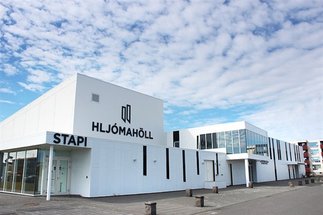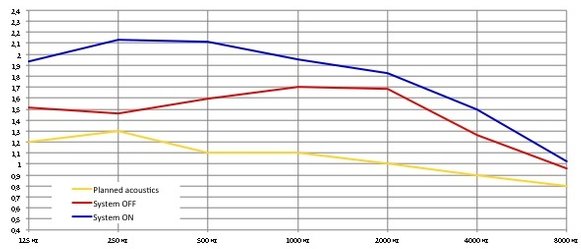Stapi
Keflavik, Island
Installed and ttuned by Panpot AS in February 2010
Installation
Stapi Hljómahöllin is a musical and conference center and also consisting a musical academy and a museum for Icelandic pop and rock&roll culture. The client for this project is Eignahaldsfélagið Fasteign hf. and the town of Reykjanesbær. Panpot Acoustic Systems of Norway was contracted for installing a variable electro acoustics. The system alter the acoustics in the concert hall.
Comparison between the proposed acoustic and the existing acoustic after completion of the hall
According to the available diagram, the planned reverbaration time in the hall should be between 0.8 and 0.9 seconds in the 500 Hz range. The reverberation time should be slightly higher in the low-frequency range (up to 250 Hz) and have a very moderate slope down in the higher frequency range.
The following diagram is taken from the file 'CATT019' of the acoustic planning documentation.
AkustikonCATTProposed reverberation time diagram
After the completion of the hall, the electronic enhancement system was installed and measurements were taken with and without the system.
The measurement result without the electronic system shows some deficiencies in the general acoustical behavior of the hall.
Probably because of the use of gypsum boards throughout the hall as main wall material and the use of acoustic reflectors consisting of plywood boards, the low frequency energy absorption is relatively high compared to the mid frequency band.
Also because of the use of gypsum boards with a very plain and even surface for all wall surfaces the reflectivity of the hall is increased.
Both properties of the hall (high low frequency absorption and high mid frequency reflectivity) are the cause of a room acoustical behavior that doesn't comply with the preferable optimum and doesn't comply with the proposed characteristics from the acoustical design of the hall.
The measurements of the hall with completed reflectors is shown in the image abow
Measurements in the room, without electronic enhancement shows that the three parameters Early Decay Time, T20 and T30 apares quite identical. This is a good indication that the general acoustic is consistent.
The measurement was taken at several different positions throughout the hall and also show a good consistency in the behavior.The above described problems with the energy distribution over frequency are clearly visible in the statistical average of all measurements (diagram below). The reverberation time in the mid frequency range is too high because of too many reflective plain walls and the low frequency range is (compared to the mid frequency range) too short because of the low frequency absorption of the gypsum board material used throughout the hall.
Electronic enhancement (AES)
The electronic enhancement system is able to increase the reverberation time to create a good environment for musical reproduction and concerts. The system uses the natural acoustic resources in the hall to create a statistical reverberation field that amplifies the natural quality of the hall. If a certain frequency range is over- absorbed in the hall, it is only partly possible to restore this range because the high damping (absorption) in this frequency range immediately absorbs the created acoustical energy (from the electronic system) also. To boost these area a much higher energy input is needed and this is not possible with microphone-loudspeaker systems because of the effective gain before feedback in such a system.
Only if the entire range of the reverberation field is increased, the low frequency range will be improved too (see image abow with the measurement).
Still the low frequency energy range compared with the mid frequency range is slightly too low to create an optimum concert hall acoustic. But based on the existing conditions the result is very satisfactory. The shortage of low frequencyenergy could be detected in symphonic music performances comparing the impression and loudness of bass players to the loudness of mid frequency instruments. To avoid negative effects by having different loudness levels between different instrument groups careful adjustments should be taken during rehearsals in the hall. But these problems are very common in many regular concert halls.
It can be said in general that the acoustical properties of the hall are still good and the hall is able to provide good sensations for the audience and the musicians on stage.
More info please contact
Epost: jowang@panpot.no



